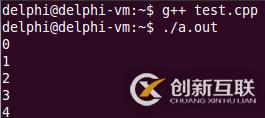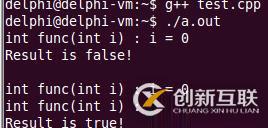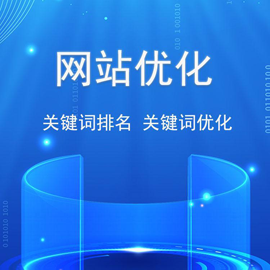C++--智能指针、逻辑操作符的陷阱-创新互联
一.智能指针
内存泄漏(C++主要的Bug来源)
1.动态申请堆空间,用完后不归还
2.C++语言中没有垃圾回收机制
3.指针无法控制所指堆空间的生命周期
代码示例

#include <iostream>
#include <string>
using namespace std;
class Test
{
int i;
public:
Test(int i)
{
this->i = i;
}
int value()
{
return i;
}
~Test()
{
}
};
int main()
{
for(int i=0; i<5; i++)
{
Test* p = new Test(i);
cout << p->value() << endl;
}
return 0;
}
运行的结果如图所示
可以看出输出结果如预期一样,但是指针在申请了内存之后没有进行释放,但当出现大量的数据时,程序会崩溃
智能指针的需求与目的
1.需要一个特殊的指针
2.指针生命周期结束时主动释放堆空间
3.一片堆空间最多只能有一个指针标识
4.杜绝指针运算何指针比较
解决方案
1.重载指针特征操作符(->)
2.只能通过类的成员函数重载
3.重载函数不能使用参数
4.只能定义一个重载函数
代码示例
#include <iostream>
#include <string>
//智能指针的实现
using namespace std;
class Test
{
int i;
public:
Test(int i)
{
cout << "Test(int i)" << endl;
this->i = i;
}
int value()
{
return i;
}
~Test()
{
cout << "~Test()" << endl;
}
};
class Pointer
{
Test* mp;
public:
Pointer(Test* p = NULL)
{
mp = p;
}
Pointer(const Pointer& obj)
{
mp = obj.mp;
const_cast<Pointer&>(obj).mp = NULL;
}
Pointer& operator = (const Pointer& obj)
{
if( this != &obj )
{
delete mp;
mp = obj.mp;
const_cast<Pointer&>(obj).mp = NULL;
}
return *this;
}
Test* operator -> ()
{
return mp;
}
Test& operator * ()
{
return *mp;
}
bool isNull()
{
return (mp == NULL);
}
~Pointer()
{
delete mp;
}
};
int main()
{
Pointer p1 = new Test(0);
cout << p1->value() << endl;
Pointer p2 = p1;
cout << p1.isNull() << endl;
cout << p2->value() << endl;
return 0;
}运行的结果如图所示
可以看到,指针在在对堆空间使用完之后,会自动释放内存
小结
1.指针特征操作符可以被重载
2.重载指针特征符能够使用对象代替指针
3.智能指针只能用于指向堆空间中的内存
4.智能指针的意义在于大程度的避免内存问题
二.逻辑操作符的陷阱
A.逻辑运算符的原生语义
1.操作数只有两种值(true与false)
2.逻辑表达式不用完全计算就能确定最终值
3.最终结果只能是true或者false
代码示例
#include <iostream>
#include <string>
using namespace std;
int func(int i)
{
cout << "int func(int i) : i = " << i << endl;
return i;
}
int main()
{
if( func(0) && func(1) )
{
cout << "Result is true!" << endl;
}
else
{
cout << "Result is false!" << endl;
}
cout << endl;
if( func(0) || func(1) )
{
cout << "Result is true!" << endl;
}
else
{
cout << "Result is false!" << endl;
}
return 0;
}

Q:逻辑操作符可以重载吗?重载逻辑操作符有什么意义?
代码示例及结果
#include <iostream>
#include <string>
using namespace std;
class Test
{
int mValue;
public:
Test(int v)
{
mValue = v;
}
int value() const
{
return mValue;
}
};
bool operator && (const Test& l, const Test& r)
{
return l.value() && r.value();
}
bool operator || (const Test& l, const Test& r)
{
return l.value() || r.value();
}
Test func(Test i)
{
cout << "Test func(Test i) : i.value() = " << i.value() << endl;
return i;
}
int main()
{
Test t0(0);
Test t1(1);
if( func(t0) && func(t1) )
{
cout << "Result is true!" << endl;
}
else
{
cout << "Result is false!" << endl;
}
cout << endl;
if( func(1) || func(0) )
{
cout << "Result is true!" << endl;
}
else
{
cout << "Result is false!" << endl;
}
return 0;
}
可以从代码及运行结果可以看出,无论逻辑操作符是否更换两端顺序,都会对两端数据进行运算
B.问题的本质分析
1.C++通过函数调用扩展操作符功能
2.进入函数体前必须完成所有参数的计算
3.函数参数的计算次序是不定的
4.短路法则完全失效
短路法则
a.(表达式1)&&(表达式2) 如果表达式1为假,则表达式2不会进行运算,即表达式2“被短路”
b.(表达式1)||(表达式2) 如果表达式1为真,则表达式2不会进行运算,即表达式2“被短路
建议:实际工程开发中避免重载逻辑操作符,通过重载比较操作符代逻辑操作符重载,直接使用成员函数代替逻辑操作符重载,使用全局函数对逻辑操作符重载
小结
1.C++从语法上支持逻辑操作符重载
2.重载后的逻辑操作符不满足短路法则
3.工程开发中不要重载逻辑操作符
4.通过重载比较操作符替换逻辑操作符重载
5.通过专用成员函数替换逻辑操作符重载
另外有需要云服务器可以了解下创新互联scvps.cn,海内外云服务器15元起步,三天无理由+7*72小时售后在线,公司持有idc许可证,提供“云服务器、裸金属服务器、高防服务器、香港服务器、美国服务器、虚拟主机、免备案服务器”等云主机租用服务以及企业上云的综合解决方案,具有“安全稳定、简单易用、服务可用性高、性价比高”等特点与优势,专为企业上云打造定制,能够满足用户丰富、多元化的应用场景需求。
网页题目:C++--智能指针、逻辑操作符的陷阱-创新互联
本文地址:https://www.cdcxhl.com/article40/ehjho.html
成都网站建设公司_创新互联,为您提供虚拟主机、网站内链、电子商务、ChatGPT、外贸网站建设、用户体验
声明:本网站发布的内容(图片、视频和文字)以用户投稿、用户转载内容为主,如果涉及侵权请尽快告知,我们将会在第一时间删除。文章观点不代表本网站立场,如需处理请联系客服。电话:028-86922220;邮箱:631063699@qq.com。内容未经允许不得转载,或转载时需注明来源: 创新互联

- 网站改版调整前需要做哪些准备? 2014-09-18
- 网站建设服务商网站改版的优势。 2018-09-29
- 网站改版需要注意哪些方面呢? 2016-12-31
- 网页制作:网站改版保护已有排名 2021-12-15
- 网站改版哪些问题需考虑? 2020-12-22
- 企业网站改版时如何做内部页面的“微整形” 2021-08-14
- 网站改版是否应该更新域名? 2018-07-31
- 网站建设的几个考虑点以及网站改版的几点注意 2021-05-25
- 网站改版引起网站降权怎么办? 2022-03-11
- 流量统计在网站改版后不可忽视。 2019-08-01
- 网站改版对SEO优化效果还是比较大的 2022-12-16
- 天津和平企业网站改版哪些问题要注意 2020-11-30